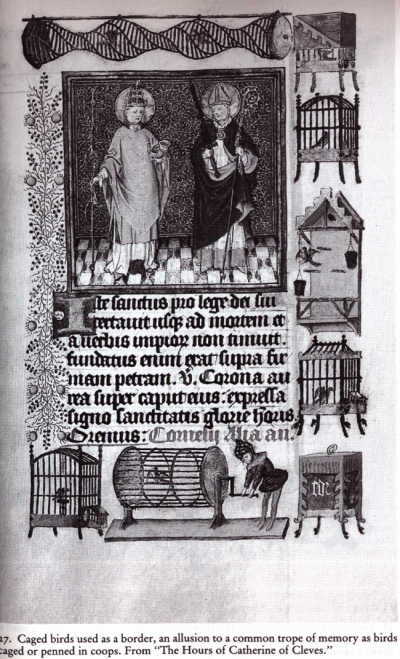Abracadabra: Language, Memory, Representation
Medieval Memory Systems
Despite the increasing circulation of books and manuscripts from the ancient to the medieval era, the memory system never disappeared. In fact, philosophical and theological writings on memory increased (such as those of Thomas Aquinas and Albertus Magnus). The techniques of the arts of memory should be seen not as a relic of a gratefully forgotten era, but as fundamentally continuous with today.
Mary Carruthers makes a very strong point (in a book called The Book of Memory) that throughout the ancient and medieval period, memory itself is conceived of as a kind of inscription-- not as something separate or preliminary to an age of literacy. Rather, the ancient and medieval scholars literally (no pun intended) wrote their memories in their brains in order to use them as they would printed texts.
Not all memory is rote memory-- The field guide is not just a list of birds; it is a guide to seeing them. Whether they actually appear in nature is only a fraction of the game, the rest is up to us. Similarly, Memory systems were always used in particular places and for particular purposes, not just to store up all the things and events of the past.
In the Medieval period, arts of memory underwent some of their most interesting changes. The medieval period in Western Europe is dominated by Christian Theology and Aristotelian science. From about the 2nd century A.D until the Renaissance, Aristotle was the premier authority for philosophers and scientists, while Augustine was probably the greatest theological authority. In the middle ages two Dominican Saints Albertus Magnus and Thomas Aquinas were equally knowledgeable about Aristotle and Augustine.
In the medieval period the memory systems of old gain new purchase: they become pious, divine, ethical, oriented towards not only rhetorical functions but ethical (concerning how to live an ethical life) as well.
In Medieval Christian philosophy there are four Virtues: Fortitude, Justice, Temperance, Prudence. It is Prudence that commands our attention, because this is the place of memoria. Within prudence, Medieval Scholars included memoria, intelligentia and providentia. A famous painting by Titian (1565) portrays the allegory of prudence with the heads of three men (an old man for memory, a middle aged bearded man for the present and young man for the future) and three animals (a wolf who has already devoured the past, a lion representing the uncertain present, and a "fawning dog" representing the future). Aquinas explains that it is only by looking carefully upon past things that we can be rightly directed to present and future things, hence Prudence, the opposite of imprudence-- of risk. Certainty comes from Memory and the proper organization of words and images. Such a temporal understanding of memory is crucial for the development of methods of scientific experiment since it makes sensible the notion of 'probability' or uncertainty as a function of knowledge.
Read Chapters 3 and 4 of Yates for more detailed information on the medieval memory systems. Note especially:
- the use of memory systems to remember virtues and vices, as a method for living.
- The notion of "Corporeal Similtudes" vs. Imagines Agentes.
- The two types of memory system: simple mnemonic and complicated Dante-esque. Yates suggest that Dante's masterwork should be considered as such a system, Petrarch also referenced frequently in this vein.

A Book of Hours made for Catherine of Cleves, Duchess of Guelders, c. 1440. Aviary memory motif also noted by Mary Carruthers; from Carruthers The Book of Memory, Cambridge University Press, 1990.